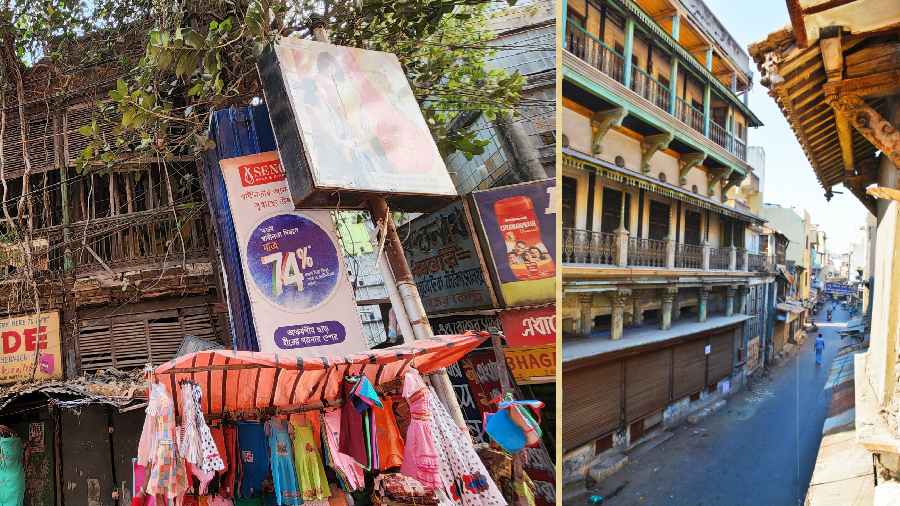No. 4 Nityadhan Mukherjee Road was the Howrah Congress party office when novelist Saratchandra Chattopadhyay was the Howrah Congress president from 1921 to 1936. It also hosted the office of the Socialist Party and was the hotbed of the trade union movement. Today, it stands decrepit, dilapidated and in a precarious condition, the gnarled roots and branches of an old ficus strangling the very life out of the concrete and wooden slatted verandah.
Two giant jewellery hoardings make a mockery of the bygone political history of the building. When the traders of Mangala Haat, a temporary marketplace that operates twice a week, peddle their wares — saris, shirts, knickers and also winter wear in the heat of April — in front of that structure, they are actually risking their lives.
This historic building would have been demolished in 2010 when an official of the Shibnath Banerjee Labour Institute, which has its office in the building, alerted the West Bengal Heritage Commission. Thereafter, an agreement was drawn up between the commission and the new owners — Chowdhury Exports Pvt. Ltd — that the building would be restored. Partha Ranjan Das, a member of the Heritage Commission, has come up with a plan and will be supervising the project.
It is Das who brings up the Transfer Development Right, better known as TDR. He says, “Declaring a building heritage is not enough to stop demolition. Owners can go to court and get an order for demolition. What we need to do is incentivise people so they do not demolish heritage buildings.”
The Calcutta Municipal Corporation has recently announced its decision to introduce TDR and amend the Town Planning Act to that effect.
This concept was developed to help preserve heritage property for those who find it difficult to maintain them and sell them off to developers. The property owner, in lieu of the land or its part being a heritage property, is awarded a TDR certificate authorised by a competent authority.
The certificate has details of the built-up area which the property owner may construct over the remaining plot or sell to property developers at an agreed value. This way, the property owner gets timely and market-based returns from the property and the heritage is preserved and maintained without any economic loss to the owner.
Says Das, “In the case of No. 4, Nityadhan Mukherjee Road, if we had a TDR mechanism in place we could preserve the house and give development rights on four cottahs of land (the area on which the house is built) elsewhere in the city or suburbs. I would not have had to draw up a plan for the developers and they would be at liberty to develop their property elsewhere.”
TDR in India has been successfully introduced in Mumbai, Ahmedabad, Bengaluru, Pune and Hyderabad. In the old city of Ahmedabad, Grade I and Grade II heritage structures can apply for TDR for restoration, says architect Debashish Nayak, who is adviser to the heritage programme of the Ahmedabad Municipal Corporation and director of the Centre for Heritage Management, Ahmedabad University.
Ahmedabad is the first city in India to be awarded the Unesco heritage tag. “It all started with a plan to restore the havelis and pols
(cluster of buildings) in the old city. After TDR was introduced in the Town Planning Act, there have been plenty of applications to the Heritage Commission in Ahmedabad. It (TDR) took three to four years to crystallise and now we have a single window system for TDR clearance,” says Nayak, who is from Calcutta and has mapped historical buildings in the city.
TDR has worked well in the old city of Ahmedabad, where there is no open space. “That portion of the city has 100 per cent built-up space, so contractors wanting to build in new open areas can buy TDR from the old houses,” says Nayak. The old city today has a number of restored havelis which function as fashionable homestays for foreign tourists wanting to sample “authentic Indian life”. But then again in Mumbai, TDR has not quite worked.
How Bengal works with TDR remains to be seen. Das has a poor opinion of the state’s heritage policy, but retired Bengal chief secretary and member of the heritage commission Alapan Bandyopadhyay obviously thinks otherwise. In a seminar organised recently by the Merchant Chamber of Commerce and Industry, he said, “There are rudiments of policy subsets... The thing is we do not have a comprehensive list of heritage buildings. If a list is done and graded, I don’t think heritage buildings will be allowed to be demolished.”
According to Bandyopadhyay, what is lacking is a precise plan to incentivise heritage property owners to maintain their property.
Heritage Commission chairman Shuvaprasanna shared an anecdote — at the same seminar — which only proved that this dragging of feet and prolonged hesitation is also our heritage.
The veteran artist recalled the time Nobel laureate Gunter Grass visited Calcutta. “The then chief minister (Buddhadeb Bhattacharyya) told me he wanted to meet Grass. Next day I took him to Nandan. We talked, Grass was very excited about Calcutta’s heritage, north Calcutta should be turned into a heritage zone, he said. He proposed that he would get the German chancellor to conserve north Calcutta.”
Shuvaprasanna added after a pause — “Nothing came of it.”











